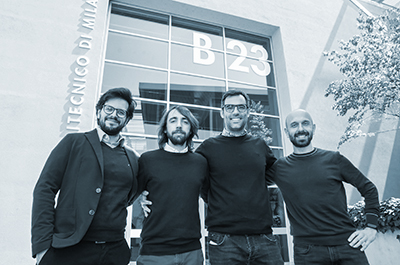
The “Call for Researchers” initiative of the Department of Mechanical Engineering is now in its second year. It is a competitive call for which the candidate, also the scientific director of the project, must choose a research topic and pick a research team to bring diverse skills to the table. Interdisciplinarity is the main application requirement as the goal is to make researchers from different DMEC Research Lines cooperate while involving other Italian and foreign Universities.
For the 2021 edition, our researchers were asked to submit research projects related to the Sustainable Development Goals (SDGs). The Evaluation Committee received five research proposals coordinated by: Stefano Arrigoni presenting the “Intelligent Transportation Services for POLIMI (IT4POLIMI)” project, Niccolò Becattini presenting the “Manta Ray-inspired microplastics filtration unit for domestic and industrial applications (MANTRA)” project, Dayou Ma presenting the “Development of Stochastic Numerical Model for Quality Design of Nanocomposites (SIMONE)” project, Luca Michele Martulli presenting the “Structural sMARt fabric with TunablE properties (SMARTEX)” project and Paolo Schito presenting the “COACHING FOR RTDx (COACH)” project.
According to the criteria indicated in the call, the Committee appointed the SMARTEX project as the winner. Congratulations to Luca and sincere thanks to all the researchers who participated in the competition.
Before introducing Luca's project, a greeting to all the researchers of the Department of Mechanical Engineering and see you soon at the 2022 edition of the Call for Researchers.
“I think that the underlying objective of the “Call for Researchers” is to allow young researchers to create new networks within the Department of Mechanical Engineering. This was especially important to me, since I joined Polimi only in November 2020” declared the scientific director of SMARTEX, Luca M. Martulli, winner of the last edition of the Call for Researchers issued by the Department of Mechanical Engineering within the Dipartimento di Eccellenza project LIS4.0.
The research object of the SMARTEX projects are smart fabrics are textile-like structures capable of responding to environmental stimuli. Most of the research and industrial efforts is currently focused to the development of smart fabrics that implement electronic features; these so called “e-textiles” have been traditionally used as sensors in medical devices, wearable electronics and energy harvesting applications. Only little effort was spent in the possibility of prototyping Structural Smart Fabrics (SSFs), namely smart fabrics with tunable mechanical properties. This is in contrast with the clear need for smart materials featuring variable mechanical properties, witnessed by the development of technologies like 4D printing or shape memory materials. SSFs are textile-like structures that can be geometrically and functionally optimised thanks to the advent of 3D additive manufacturing which enables to produce chainmail-like fabrics. One of the main potentials of these structures is the possibility to adopt interlocked discrete cells, opening new possibilities in creating stiffness-tailored fabrics. To enhance these properties, functional materials such as Shape Memory Alloys (SMAs) can be used thanks to their capability to mechanically react under external stimuli. Potential applications for SSFs extend to lightweight space structures, soft robots, medical devices and more. SMA actuated SSFs will thus broaden the possible applications of smart fabrics, providing them with the capability
to adapt to variable functional specifications in terms of shape and stiffness.
Within this context, the SMARTEX project aims to advance the current state of the art on smart fabrics by designing, manufacturing and testing an SSF actuated by SMAs. SMARTEX will make extensive use of additive manufacturing techniques, which makes it fully compliant with the needs of the Industry 4.0. Moreover, the use of SMAs as actuating devices will make the SMARTEX fabric sensitive to temperature or to an electric current as signal.
SMARTEX will therefore be a 3D printed chainmail-like SSF responsive to temperature thanks to the assembly with SMA actuation devices. In this regard, SMARTEX can be seen as a hybrid structure made by two components. At room temperature, being the SMA device in its soft condition, SMARTEX will be in its “inactive” state. SMARTEX will have a near-zero bending stiffness and thus behave as a standard fabric, being flexible enough to be folded or bent. At high temperatures, SMARTEX will be in its “active” configuration: the SMA device will activate, jamming all the fabric cells between each other. The bending stiffness of SMARTEX will thus significantly increase, behaving more similarly to a plate and being capable of carrying loads.
While the SMARTEX project does not focus on a specific application, it will develop an extremely versatile new smart fabric with unique properties and its dedicated design approach. The developed fabric is thus expected to have a vast range of applications, like soft robotics, space components, support for heat shields, biomedical devices and more.
"Thanks to this call – continued the young scientific director Martulli - I was able to meet the members of what later became the SMARTEX team: Luca Patriarca, Paolo Parenti, Marco Rossoni and myself. Together, we form a multidisciplinary team, with expertise including experimental mechanics, analytical and numerical modelling, composite materials, Shape Memory Alloys, 3D printing, virtual prototyping and more. These are all key ingredients in the development of an innovative type of smart fabrics”.
